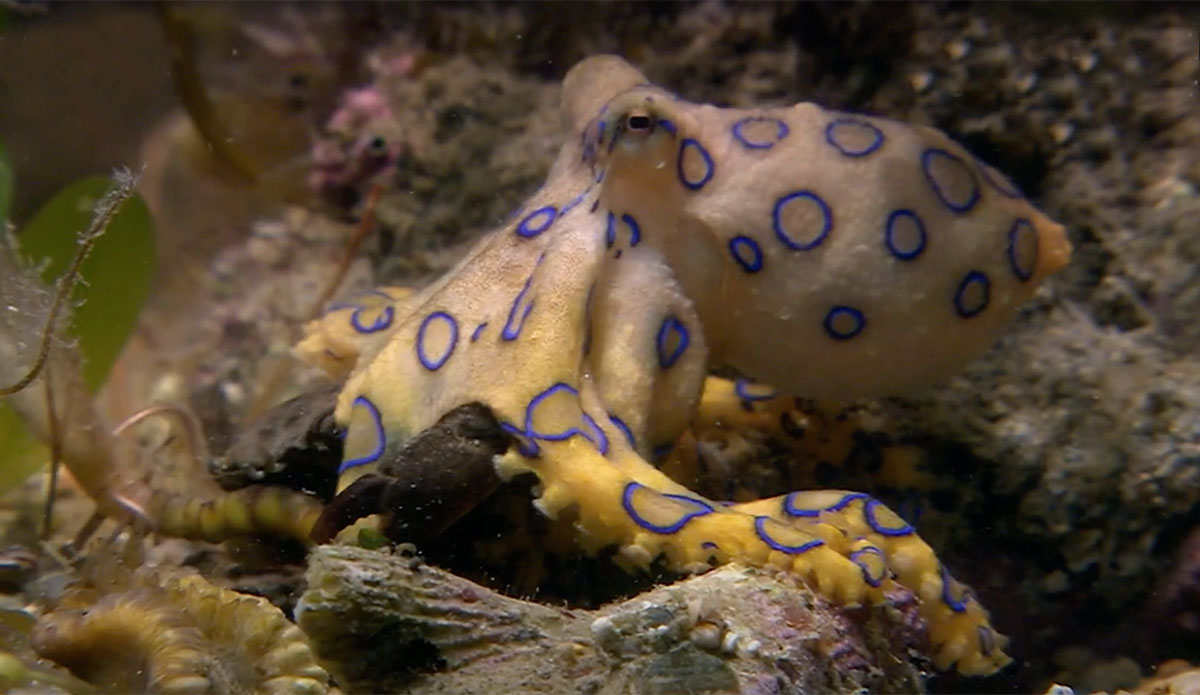
The woman was bitten twice by a blue-ringed octopus and lived to tell the tale. Photo: Screenshot/YouTube
On March 16, a woman was hanging around at Chinamans Beach in Mosman, New South Wales. While she was swimming she found a pretty little shell, like many of us have, and picked it up to appreciate it. As she was rolling it around in her hand, a tiny little creature fell out, landed on her stomach and, in the blink of an eye, bit her twice. And if it weren’t for modern medicine, that might’ve been the end of the road for her. The tiny little creature hiding in the shell was a blue-ringed octopus, one of the most venomous animals in the world.
“At first glance, the blue-ringed octopus looks perfectly innocuous,” wrote the Ocean Conservancy. “Its psychedelic coloring and pint-sized packaging make it seem more adorable than alarming. But don’t let its cuddly exterior fool you: this tiny octopus can kill you. And quickly.”
Blue-ringed octopuses (no, it’s not octopi) generally spend most of their time in the soft sand at the bottom of shallow tide pools or in coral reefs. They don’t do much other than try and stay hidden, and they certainly don’t want any trouble from some ham-handed human. When they feel threatened, they produce wildly bright blue rings all over their body and as a last resort, will stick you with their beak and squirt a bit of toxin into you.
A little known fact about all octopuses: they’re all venomous. But the blue-ringed octopus is venomous on a whole different level. Inside that tiny little body is a neurotoxin called tetrodotoxin, which is decidedly bad for human beings and pretty much anything else. It’s the same stuff found in a pufferfish, and it’s made in the blue-ringed octopuses salivary glands. It’s way more potent than anything found on land, but it’s almost exclusively used by the blue-ringed octopus when it’s hunting for tiny little creatures to eat, like crabs, shrimp, and the occasional tiny fish. It uses its beak to introduce the venom, which paralyzes the prey, then eats it while it can’t move.
So here’s what happens to a person bitten by a blue-ringed octopus, as told by scientists at the Ocean Conservancy:
“First, the venom blocks nerve signals throughout the body, causing muscle numbness. Other symptoms include nausea, vision loss or blindness, loss of senses and loss of motor skills. Ultimately, it will cause muscle paralysis—including the muscles needed for humans to breathe, leading to respiratory arrest. There is no known antidote, but victims can be saved if artificial respiration is started immediately.”
The problem, however, with the bite of the blue-ringed octopus — aside from its lethality, of course — is that it’s pretty painless, which means you might not know you’ve been bitten until you’re blind and gasping for air. Thankfully, that was not the case for the woman in New South Wales, Australia. Luckily, the blue-ringed octopus isn’t aggressive and only two people have died from its bite since the ’60s.
According to the NSW Ambulance Service, by the time they got to the woman, she had some “abdominal pain around the bite site.” Paramedics applied pressure and a cold compress, then took her to Royal North Shore hospital to get a full run down and be treated for further symptoms from the bite.
“A blue-ringed octopus bite is a rare call for us,” Inspector Christian Holmes said in a statement on Facebook, “but they are extremely venomous.”
According to reports, the woman, who is in her thirties, is in stable condition and will recover from her bites. But she’ll probably think twice about picking up shells in the future.

